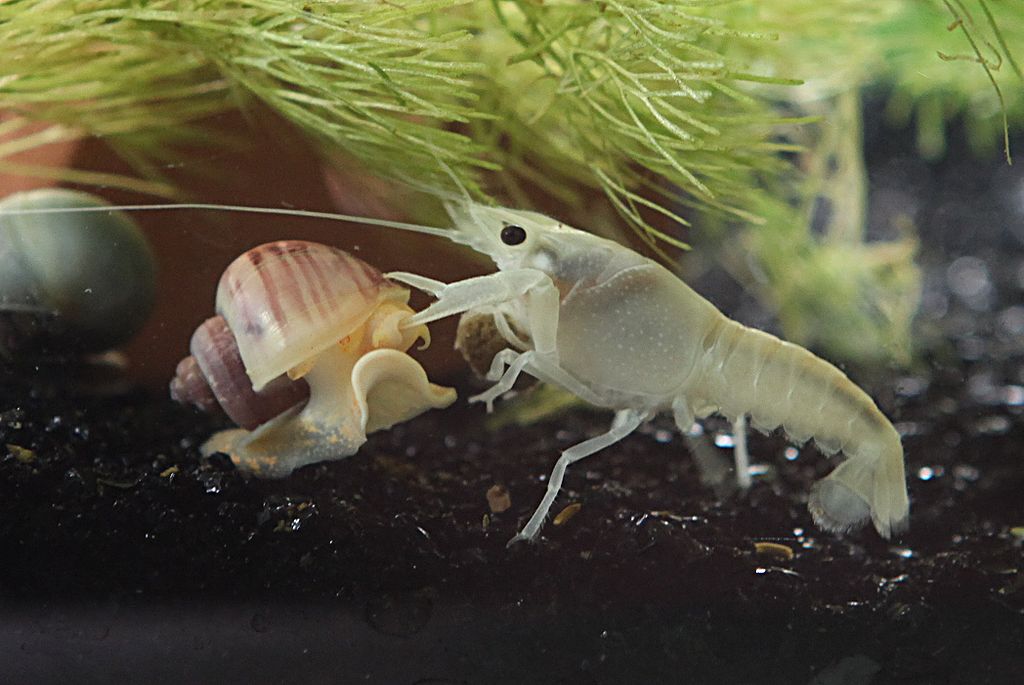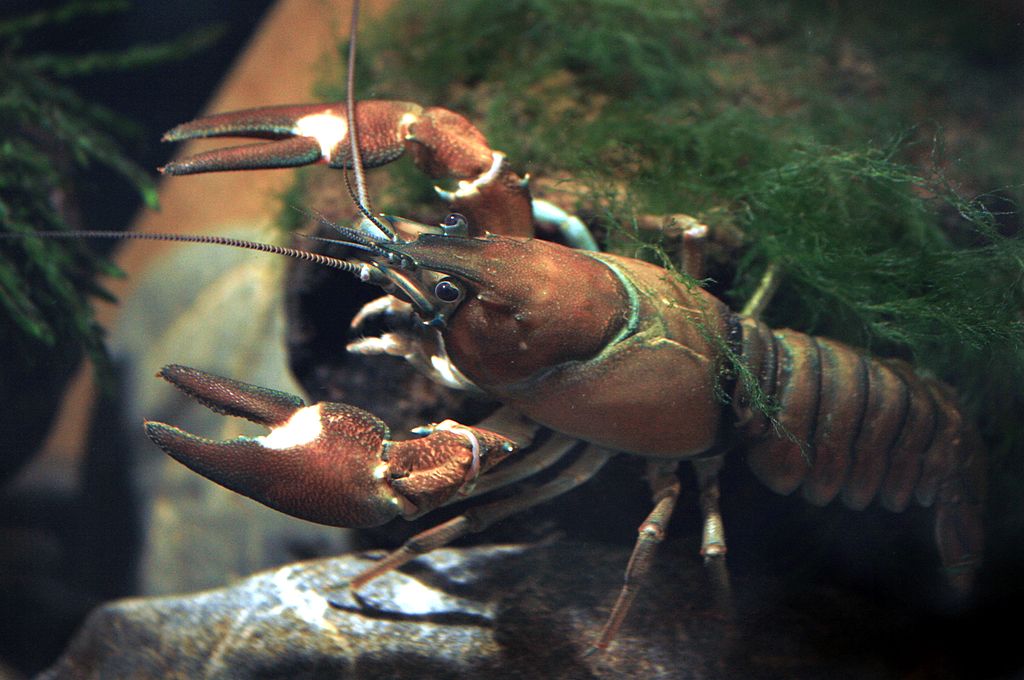It’s not only limited to fish when we talk about freshwater species to keep in a tank. In fact, many other creatures are just as popular as fish. One of the most popular non-fish species is crayfish.
Crayfish are small lobster look-alike freshwater crustaceans. Their unique look and striking colors make them very well-known. If you are looking for some eye-catching species, crayfish can make an excellent addition to your tank.
If you’re planning to get them, you may be wondering now, what do crayfish eat? Short answer, many things. Crayfish are not picky when it comes to feeding, which is a plus point. But that does not really answer the question, we suppose.
Therefore, we will discuss the mini freshwater lobster’s diet in detail today. Let’s dive in!
Table of Contents
Species Overview
Crayfish (Cambarus sp.) are freshwater crustaceans that are still closely related to lobsters. They belong to the superfamilies of Astacoidea and Parastacoidea and Decapod order. Oftentimes, they are mistaken as lobsters due to their similar appearance. However, crayfish are completely different since they are way smaller and don’t live in saltwater.
Apparently, crayfish’s name is not universal since it refers to different species in some areas. In Australia, New Zealand, and South Africa, crayfish or cray are spiny lobsters (of the Palinuridae family) that inhabit saltwater.
Crayfish has many other common names. In some regions in the United States, they are called crawfish, crawdads, mudbugs, freshwater lobsters, mountain lobsters, rock lobsters, or yabbies.
There are more than 500 species of crayfish from four extant families (Astacidae, Cambaridae, Cambaroididae, Parastacidae). You can find all four families throughout many countries, with 3 families in Northern Hemisphere and one in Southern Hemisphere.
A wide range of crayfish inhabits freshwater bodies in Australia, New Zealand, and North America. They are also spread across Asia and Europe.
In many countries, people often cook crayfish and serve it as a delicious meal. But due to their beautiful appearances, many people gain interest to keep them as pets.
Crayfish have a variety of colors. They come in electric blue, red, orange, and many more. As for the size, they can reach a length of 6.9 inches (17.5 cm).
Besides their stunning look, crayfish are also sturdy and not demanding. Those traits make them very attractive to be an addition to the tank.
What Do Wild Crayfish Eat?
Crayfish typically reside in shallow lakes, rivers, or streams with fast-flowing currents in their natural habitat. The water is usually packed with rocks, heavy vegetation, and leaves litters with muddy ground.
They tend to stay in the superficial water bodies’ because it is difficult for them to reach the surface to get their meals. The fast water streams also help them reach onto their foods as they are not the best swimmers.
Besides, the fast flow also provides natural habitat cleansing for the crayfish. A good flow can effortlessly sweep all litter and dirt along the way. In short, it keeps the water clean and well-oxygenated.
The crayfish are omnivores. They are not picky at all and will gladly devour anything in front of them! In the wild, their nutrition supply mostly comes from decaying aquatic creatures and vegetation.
The decaying matter includes dead fish or other creatures and rotten leaves as those are mostly drift along with the stream. On top of that, the crayfish also eat algae they find on rocks or twigs (they even eat the twigs).
Crayfish generally don’t catch live fish in the wild, although it is still possible. Due to the fast currents and plenty of space in the water, fish can just avoid the crayfish’s grip. But that doesn’t mean the decapods cannot fulfill their protein need.
Luckily, crayfish like to stay on the riverbed and are good diggers. There, they can find the protein sources such as worms or small shrimps. If they couldn’t find any, they will even eat their own species since they are infamous for being cannibals.
Reported that crayfish also prey on other small creatures such as baby turtles, tadpoles, to adult frogs.

What Do Crayfish Eat In Aquariums?
We have discussed crayfish’s natural environment earlier. If you’re planning on stocking them in your tank, it’s best to mimic their home in the wild.
This prevents the crayfish from getting stressed since they are in a new environment. If that happened, they will lose their appetite and might result in a fatal condition.
Crayfish’s natural habitat is highly vegetated, filled with woods or stones, and has fast-flowing currents. In the aquarium, you can provide them the same things.
You can create flows similar to rivers or lakes with a water filter by putting the outlet on the surface. Other than filters, you can also use water or an air pump.
Caves and rocks will be the best hiding spots for them. Crayfish tend to hide away from lights as they are nocturnal. You may also see them digging holes on the bottom of the tank. For that matter, filling the tank with a smooth sandy substrate is appropriate for them.
As for plants, we recommend you get the hardy and fast-growing ones like java moss and hornwort. Other plants will also do, but chances are they will be gone in a short time.
Now, let’s find out what those plants are. As well as other various food you can give the crayfish to meet their nutrition needs.
Live Plants
On top of being a shelter, plants are also a good food source. That’s because they are planted inside the tank, which makes them always fresh.
But keep in mind, aquatic plants can mean two things to crayfish. If you grow plants specifically to feed them, then this will be a good thing. But if you plant it as a decoration in your tank, then be prepared to be disappointed because your crayfish will most likely destroy it.
Some aquatic plants you can get are Cabomba, Java Moss, Densa, Hornwort, Micra, and Hydrilla. Fun fact, some people feed their crayfish hydrilla because it is believed that hydrilla helps enhance the color.
Crayfish will also feed on algae if you count that as a plant.
Commercial Foods
Crayfish are no good swimmers and are not able to float. Therefore, you need to make sure the food you give sinks to the bottom.
Some commercial foods that can easily be eaten by crayfish are shrimp pellets and algae wafers.
Frozen & Live Foods
Just like humans, the crawdads are omnivores that eat everything. They need variety in their diet to fulfill their nutritional needs and not get bored.
Besides plant matter, you need to provide them protein sources of food. This includes live foods such as shrimp and small fish or frozen one like blood worms. Before you give frozen food to the crayfish, make sure to defrost it first.
Other meat matter food you can offer them are mosquito larvae, daphnia, insects, snails, and squid. Feeding them meat-based food regularly, however, will cloud the water easily. To prevent it, you can feed them live foods once or twice every month.
Fruits & Vegetables
It’s not recommended to feed the crayfish store-bought or live food daily. You need to give them fruits and veggies as well. Besides adding variation, vegetables and fruits also complement the nutrition supplies from other foods.
Vegetables you can give the crayfish are zucchini, lettuce, carrots, and peas. Before feeding veggies to your crawdads, you need to boil them and cut them into small chunks. How simple is that?
As for fruits, we suggest not give them regularly. Just as treats every once a month is fine. In that case, you can offer them grapes, pears, apples, etc.
What Do Baby Crayfish Eat?
Crayfish begin their lifecycle as eggs. It takes approximately 3 to 4 weeks for the eggs to hatch, and the fries start to appear. The process depends mostly on the temperature and water conditions where the eggs are.
The babies will grow quite rapidly to become tiny crayfish. They only need around 15 days to reach the length of ½ inch (1.3 cm).
Due to their small size, they can’t eat the same foods as the adults (in terms of size). But don’t worry, the fries are just as easy as the grown-ups to care for. Meaning that they are not picky eaters and will take most anything.
To feed the babies, you can crush some pellets or algae wafers into powder and sprinkle them into the tank. Keep in mind that crayfish don’t swim to catch their food. So even the powdered pellets need to reach the bottom.
For every once a week, you can give very soft boiled veggies to the babies. That will help to balance their diet.
As babies, crayfish tend to eat more protein-based food and more aggressively than adults. Therefore, giving them more pellets is better than plant matter food. If you can, check whether the fries are actually eating to ensure their healthy growth.
Generally, baby crayfish will stick around the mother’s tail to get food. However, they cannot be kept together as crayfish are notorious for eating their babies.
When they are juveniles, you can feed them the same foods as the adults. At this stage, you may also notice that their diet change. Grown-up crayfish prefer plant-based foods to meaty foods, so you will need to check on that.
How Often Do You Need to Feed Your Crayfish?
Naturally, crayfish are scavengers. They will check on almost every corner of the tank and hunt for food. You can catch them eating excessive algae or even uneaten food from other tank inhabitants!
Since the crayfish are quite independent, is it necessary to feed them every day? Not really, you can give them food once every two days. You can also feed them every day if you will, although not really recommended.
Providing food for your crayfish every day will pollute the water quickly. Also, some sources say that crayfish can go up to a week without food!
If you provide food for the crayfish every day, it needs to be in a small portion. Preferably an amount they can finish in a few minutes. Pro-tip, foods of size ¾ inch are best suitable for them. Whether it’s cut-up meat, veggies, or pellets.
A wide range of variety of food is good for the yabbies’ diet. This ensures their nutritional needs are met. And how do you do that? We will give you an example. On Monday, you can feed them blanched vegetables. For the next day, you give them bloodworms and other different food for the next coming days. You can decide on the menus.
It’s good to have a fixed schedule when feeding the crayfish. This species is quick to pick up routines. They might even wait for you when they’re already familiar with the timetable.
It’s also important to not overfeed the crayfish as it will lead to some problems in the future. On top of that, leftover foods will also contaminate the water and makes it unsanitary.
Summary
As omnivores, crayfish will happily receive everything you offer them. Feeding them a different menu every time can help to balance their diet. Besides, changes in foods will keep feeding time always interesting for the crayfish.
It’s important to satisfy crayfish’s nutritional needs to ensure their healthy and happy life. When you buy foods from the store, make sure to check the ingredients. Well-known brands are not necessarily the best.
With a healthy and balanced diet, you can see your crayfish become strong and happy!
Well, that’s our answer to frequently asked questions about what do crayfish eat in the wild and aquariums. If you think that we missed out on anything, please don’t hesitate to tell us in the comment section below.






